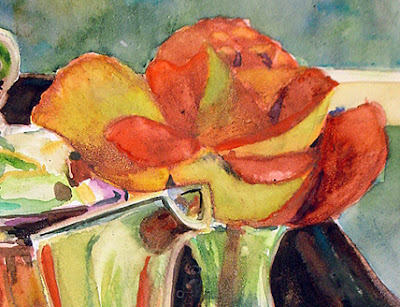1. Taking great reference photos.
2. Opaque Pigments.
Can you tell that it's the last day of April and I'm sad? I'm sneaking in 2 quick tippettes for you today as my parting gift!
Taking great reference photos:
I've got to give credit to Michael Cyra, my friend, painter, photographer and owner of PHOTOGRAPHICS (located at FreshFields near Kiawah) for sharing this tippette with one of my painting groups earlier this year. Note: Although I'm about to try to explain to you what he told us, I know I don't have the photography jargon down pat (sorry, Michael!). Try to bear with me.
You know that, if the highlights in your photos are always too white and your darks too black, you must correct for that when you paint. The photo is lying. But HOW do you correct it? Check out this photo below of some Spanish moss that I took this week:
.jpg) |
| Highlights are blown out. |
I knew when I shot this (and looked at the file on the camera), that it was wrong. That is NOT what I saw in front of me in real life. Although the trunks and water look right, the moss area looks like there's snow on it.
To correct the situation, hold down the shutter while hovering over the moss (the lightest area). Then, while still holding down the button, reposition the camera so it's in the center of what you want to shoot, and click the shutter button. What you'll get looks like this below:
.jpg) |
| Darks are too dark. |
What do I hear you saying? This one's not right either? Right! In the 2nd one, the top looks right, but the bottom is too dark. As the artist, you need to combine the two and then you have a shot at having a realistic painting. Bracket your shots!!! Thanks, Michael, for this invaluable insight. p.s. there are more scientific ways of bracketing your shots, but my artist's mind won't allow me to go there.... :(
Opaque Pigments:
I try to stick with transparent colors for the most part, but sometimes when you drop one transparent color into another one, you'll get a very subtle result for the most part. However, think about dropping opaque color into transparent, and you'll ALWAYS see the result. Check out this close up of a painting of mine. I used a combination of Naples Yellow & Cerulean Blue for this mixture that I dropped into my dark wash. Notice how it holds its shape pretty well too!
Have fun. Be courageous. Be curious. It's only paper and paint.
Let's keep in touch. It's been my pleasure to share a few things with you this month.
Ci sentiamo presto! Talk to you soon!
(pronounced TCHEE sehn-TYAH-moh PREH-stoh)
.jpg)

.jpg)
.jpg)
.jpg)
.jpg)
.jpg)


.jpg)
.jpg)
.jpg)
.jpg)
.jpg)


.jpg)
.jpg)
.jpg)
.jpg)
.jpg)
.jpg)

.jpg)
.jpg)
.jpg)
.jpg)
.jpg)
.jpg)
.jpg)


.jpg)
.jpg)
.jpg)
.jpg)
.jpg)